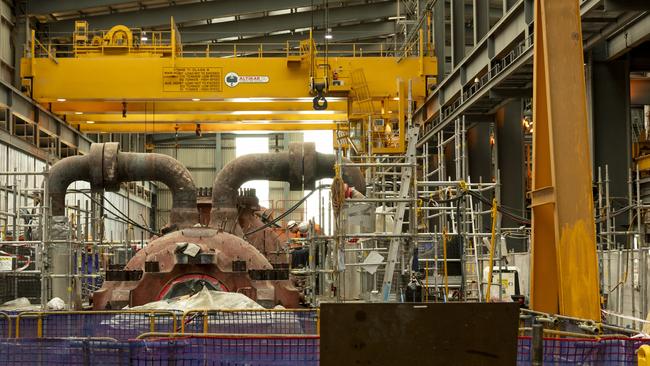How Australia’s largest coal-fired power station encapsulates the energy transition
Eraring was to close next year but will continue to produce power until at least 2027. Meanwhile Origin is spending $80m on a refit, while simultaneously building one of Australia’s largest batteries.
Amid the roar of Australia’s largest coal power station, so loud that workers have to wear ear protection, a crew of a dozen or so men in bright orange overalls is carefully dismantling a near 35-tonne turbine for maintenance – ahead of being thrust back into service until perhaps nearly the end of the decade.
Just a few hundred metres away, a construction crew is also busy. But they are installing row after row of modules in what, in just a few months, will become one of the country’s largest batteries.
Although jarring, the contrast embodies Australia’s energy transition – rapidly shifting to renewables but not quite quickly enough to mean coal isn’t needed for that little bit longer.
Anthony Ham, group manager of coal asset operations at Eraring, said Origin was spending about $80m on this enlarged major maintenance of the power station, in which about 500 contractors, with assistance from specialists from Japan and Korea, will dismantle large amounts of unit 3 to clean and repair any issues. About 1100 tonnes of scaffolding will be required for the job that Origin hopes to complete by November – just in time for summer, when electricity demand spikes for cooling.
“That gives us another five years of certification,” Mr Ham says, though Origin has a hard stop on the facility for 2029.
Eraring was until this year set to close in 2025, but with the Australian Energy Market Operator and an array of experts warning that electricity supplies in NSW could not be guaranteed and bills would inevitably rise – the state government and Origin struck a deal this year to keep the plant open until at least 2027.
Origin could even elect to keep it open until 2029 if Australia’s energy transition fails to deliver the acceleration that the federal government insists is coming.

But for at least the next three years, Eraring will churn through as much as 25,000 tonnes of coal each day during peak periods – a striking amount for opponents of fossil fuels though the importance of the power station is unquestionable.
Eraring in Lake Macquarie, 120km north of Sydney, on any given day provides between 22-28 per cent of NSW’s electricity, and its importance was demonstrated most vividly in 2022 when it was forced to lower output when it was unable to get sufficient quantities of coal, a key driver in an explosion in household electricity bills in 2022 and 2023.
It is this scale that means Australia cannot afford for Eraring to close, and why thousands of tonnes of coal are delivered to Eraring each day via direct conveyors connected to a nearby mine or from four trains that unload coal from the Hunter Valley.
About 1.5m tonnes of coal is stockpiled at Eraring.
These piles of coal are intended to give Australia enough time to complete its transition to renewables. The federal government has set an aggressive target of having renewables generate 82 per cent of the country’s power by the end of decade.
Progress has been stubbornly slow. Still, the penetration of renewable energy is topping 40 per cent on average and Labor insists its strategy of underwriting vast amounts of wind and solar will accelerate progress even more.
Australia’s greatest acceleration is in batteries, where the likes of Origin and its competitors are responding to market signals.
With the influx of rooftop solar, Australia’s wholesale electricity prices – the cost of producing electricity – can often fall into negative territory, meaning Eraring is charged to produce power.
It is this trend that is hastening the demise of Eraring and others, but Origin is looking to repurpose some of the 1100ha site – establishing a giant battery that will be able to charge during periods when they receive income before discharging when the sun has set – earning lucrative revenues for their operators.
Origin is now months out from completing the first stage of its large-scale battery and Jay Foggin, head of energy storage projects, says there is even scope to go to a third stage.
The shift to renewables at Eraring will end more than 40 years of coal power generation and result in the loss of more than 200 direct jobs.
Another 200 contractors are engaged by Origin to keep the plant running. As a major buyer of coal, Eraring’s demise will have serious ripple effects.
It is this impact on local communities that has stoked concerns about Australia’s energy transition, and Bianca Lowe, general manager, people & transition at Origin, said the company had been working for many years to ready Eraring’s workforce.
The company has individual plans with each employee and looks to assist those in the program by certifying their skills, retraining or aiding relocation efforts to other Origin facilities.
Ms Lowe says nearly everyone intended to stay in the community, and starting a small business shaped as the most popular choice for those leaving.
Production co-ordinator Shannon Logue joined Origin nearly 35 years ago as a trainee – and has served nearly 17 years at Eraring. He says he will be there until the last day that the generator is running.
When Origin announced Eraring would be shuttering, Mr Logue said he, with the help of Origin, accelerated plans to start a lawn maintenance business.
“It started small, then I started subcontracting some work to some friends,” he said. “It got to a point where I was comfortable that come August 2025 when the gate closes that I would roll straight into that. With the extension, I have dialled it back. This is by far the best place I have ever worked at, the best people.”






To join the conversation, please log in. Don't have an account? Register
Join the conversation, you are commenting as Logout